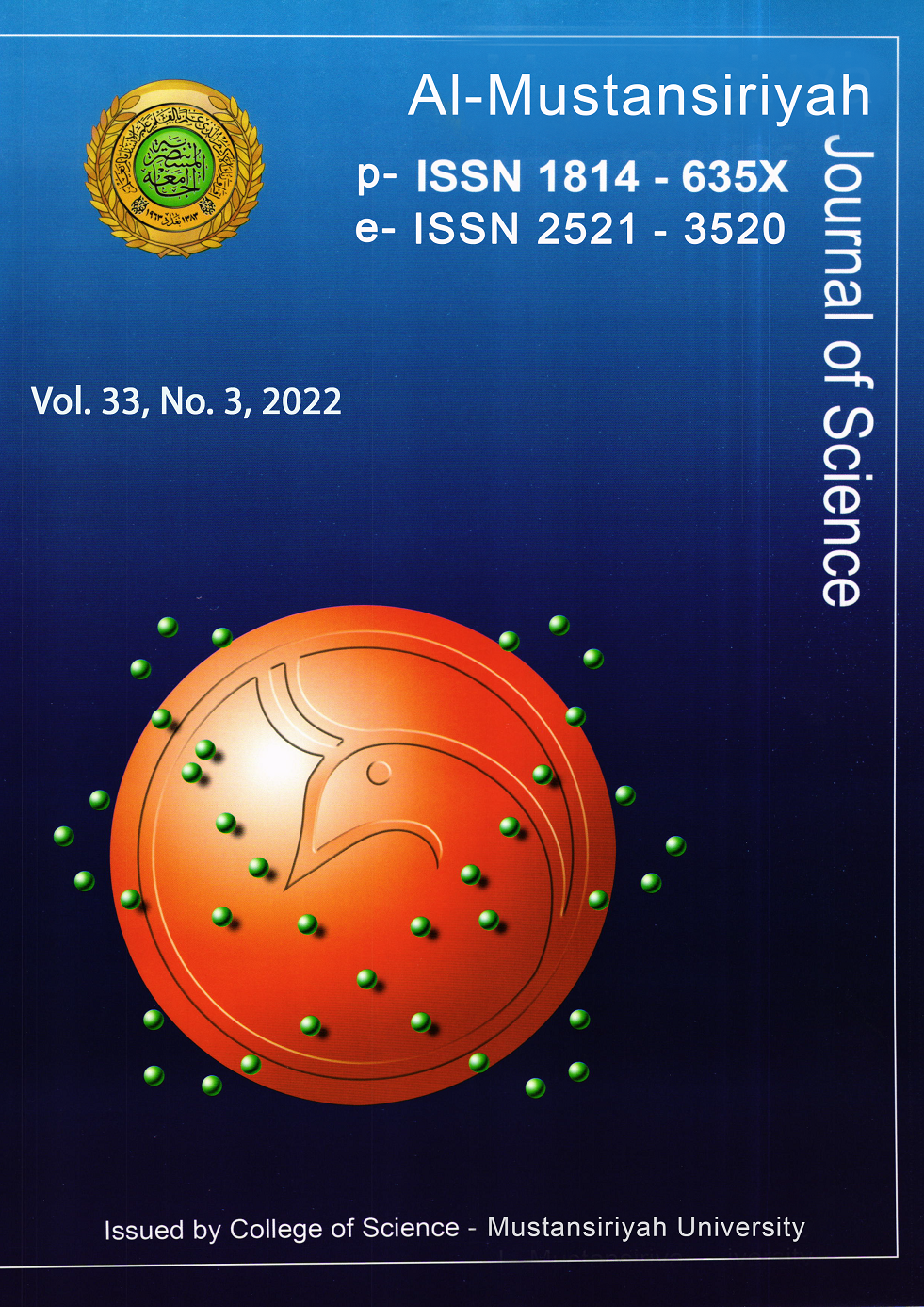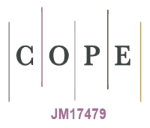Correlation of Type 1 and Type 3 Fimbrial Genes with the Type of Specimen and the Antibiotic Resistance Profile of Clinically Isolated Klebsiella pneumoniae in Baghdad
DOI:
https://doi.org/10.23851/mjs.v33i3.1129Keywords:
Keywords, antibiotic resistance, fimH1, usher-1 gene, Mrk genes, Klebsiella pneumonia.Abstract
Klebsiella pneumoniae is a member of coliform bacteria that causes wide ranges of infections including circulatory, respiratory system, urinary tract infections (UTIs), and wounds infections. This study aimed to find the correlation between type 1 and 3 fimbrial genes expression with multidrug resistance (MDR) K. pneumoniae isolates towards antibiotics. Sixty clinical isolates of K. pneumoniae were collected from three main types of samples including blood, wound and burn swabs, and urine samples. The diagnosis was confirmed by VITEK-2 system and 16s rRNA housekeeping gene. The antibiotic sensitivity profile included 16 antimicrobial agents, with extended-spectrum beta-lactamase production. PCR technique was applied to detect four genes of type-1 fimbrial genes: (usher-1, chaperon-1L, chaperon-1S, and fim-H1), beside type-3 fimbrial genes: (MrkA, MrkB, MrkC, MrkD, and MrkF). The results showed that K. pneumoniae isolates were hundred percent (100%) resistant towards ampicillin, no resistance (0%) was recorded towards tigecycline and ertapenem, while the percentages of resistance for ceftazidem, cefepime, amikacine, and amipenem were 15%, 20%, 51.7%, and 50% respectively, and the isolates showed about (13-71%) resistance to the rest antimicrobials agents. The production of extended-spectrum beta-lactamase was in 40 (66.67%) of total the 60 isolates. There was no relationship according to the statistical analysis between the type of specimen with the antibiotic resistance rates. For fimbriae type 1 genes, the largest occurrence (90%) was reported in Chaperon-1S gene and the lowest one was in Usher-1 gene (56.6%), while it was above 70% in Chaperon-1L gene and fim-H1 gene of the total K. pneumoniae isolates. The percentages of type 3 genes MrkA, MrkB, MrkC, MrkD, and MrkF were: 28.3, 76.6, 85, 51.6, and 63.3% respectively. The type-1 fimbrial genes had no significant correlation among them, however, the type-3 fimbrial genes had significance in their presence at 0.01 and 0.05 levels as they are located on the same Mrk operon. Finally, the correlation between type 1 and 3 fimbrial genes with the type of specimen and antibiotic resistance was not significant at all.
Downloads
References
Oliveira, D., Forde, B. et. al., Antimicrobial Resistance in ESKAPE Pathogens. Clinical Microbiology Reviews. 2020: 33(3).
Chatterjee, B., Puri, S. et al., Molecular Chaperones:Structure-Function Relationship and their Role in Protein Folding, 2018: Ch.8, Volume 13.
Sonbol, F., El-Banna , T. et al., Conjugative plasmid mediating adhesive pili in virulent Klebsiella pneumoniae isolates. MedPub Journals. 2021: 3 (6), PP.4.
Mahmoud, A., Biosysnthesis and characterization of some nanoparticles by using plants extracts and study their antimicrobial property against pathogenic bacteria isolated from wounds and burns. M.Sc thesis. College of Science. Diyala University, 2020.
Scavuzzi, A., Maciel, M., et. al. Occurrence of qnrB1 and qnrB12 genes, mutation in gyrA and ramR, and expression of efflux pumps in isolates of Klebsiella pneumoniae carriers of bla KPC-2. Journal of Medical Microbiology. 2017, 66: pp. 477-484.
Eghbalpoor, F., Habibi, M. et. al., Antibiotic resistance, virulence, and genetic diversity of Klebsiella pneumoniae in community and hospital acquired urinary tract infections in Iran. Acta Microbiologica et Immunologica Hungarica. 2019, 66(3): pp. 349-366.
Caneiras, C. and Lito, L., Virulence and resistance determinants of Klebsiella pneumoniae isolated from a Portuguese tertiary university hospital centre over a 31-year period. Enferm Infecc Microbiol Clin. 2019, 37(6): pp. 387-393.
Ragheb, S. Tawfick, M. El-Kholy, A. and Abdulall, A. Phenotypic and genotypic features of Klebsiella pneumoniae harboring carbapenemases in Egypt: OXA-48-like carbapenemases as an investigated model. Antibiotics J. 2020, 9:852.
Hasan, S., Inhibition the expression of fimC, fimD, fimD genes in uropathogenic E. coli using TiO2 nanoparticles biosynthesized by probiotics bacteria. Ph.D Dissertation. College of Science. Mustansiriyah University, 2021.
Clinical and Laboratory Standards Institut: A CLSI supplement for global application, 2021, 31sted. 40(1). USA.
Shankar, C., Veeraraghavan, B. et. al., Whole genome analysis of hypervirulent Klebsiella pneumoniae isolates from community and hospital acquired bloodstream infection. BMC Microbiology. 2018, 18(6).
Al-Musawi A., Genotypic and phenotypic typing of clinical Klebsiella pneumoniae local isolates. M.Sc. thesis. College of Science. Mustansiriyah University, 2018.
Hamed, S. and Hasoon, N., Molecular characterization of carbapenemase-producing Gram-negative bacteria isolated from clinical specimens in Baghdad, Iraq. J. Pure. App. Microbiol. 2019, 13 (2): pp.1031-1040.
Al-Oqaili, N., Molecular detection of β-lactamase production among klebsiella pneumoniae isolated from different clinical cases. Eurasia. J. Biosci. 2020, 14: pp. 35-41.
Abbas, A., Hamed, S., Abdulsattar, B. and Mahmood, N., Molecular characterization of SHV-2a ESBL from clinical isolates of Klebsiella pneumoniae SLA55 in Baghdad, Iraq. Annals of R. S. C. B. 2021, 25(4): pp. 10993-11006.
Wang, G., Zhao, G. et. al., The Characteristic of Virulence, Biofilm and Antibiotic Resistance of Klebsiella pneumoniae. Int. J. Environ. Res. Public Health 2020: 17. p: 6278.
Abbas, O., Mhawesh, A, and Al-Shaibani, A., Molecular Identification of Pathogenic Klebsiella Pneumoniae Strains Producing Biofilm. Medico-legal Update. 2020, 20: 3.
Wasfi, R., Elkhatib, W. F. and Hossam M., Ashour Molecular typing and virulence analysis of multidrug resistant Klebsiella pneumoniae clinical isolates recovered from Egyptian Hospitals. Scientific Reports. 2016, 6:38929.
Wyres, K., Lam, M. and Holt, K., Population genomics of Klebsiella pneumoniae Reviews. Nature. 2020:18.
Ali, A. and Al-kakei, S., Virulence factors genotyping of Klebsiella pneumoniae clinical isolates from Baghdad. Reviews in Medical Microbiology. 2020, 30(1): pp. 36-46.
Al-Kraety, I., Alquraishi, Z. and Alsadawi, A., Molecular Study of Fimh Gene in Klebisella Pneumoniae Isolated From Urinary Catheter Patients. Indian Journal of Forensic Medicine & Toxicology. 2020,14: 2.
Fehan, A., Epidemiological study of bacterial urinary tract infection in Baquba City. M.Sc. thesis. College of Science. Diyala University, 2019.
Al-Rubyaie, N., Detection of antiseptic resistance and ESBL genes in multidrug-resistant Pseudomonas aeruginosa and Klebsiella Pneumoniae from clinical and hospital environment sources. M.Sc. Thesis. College of Science. Mustansiriyah University, 2020.
Ali, A. and Al-kakei, S., Virulence factors genotyping of Klebsiella pneumoniae clinical isolates from Baghdad. Reviews in Medical Microbiology. 2020, 30(1): pp.36-46.
Luo, M., Yang, S. and Li, X. et al., The KP1_4563 gene is regulated by the cAMP receptor protein and controls type 3 fimbrial function in Klebsiella pneumoniae. PLoS One. 2017, 12:7.
Ong, C., Ulett, G. Mabbett, A. et. al., Identification of Type 3 Fimbriae in Uropathogenic Escherichia coli Reveals a Role in Biofilm Formation. J. Bacteriol. 2008,190(3): pp.1054-1063.
Ali, Z., Determination of The Inhibitory Efficacy of Some Plant Extracts and Probiotics against Klebsiella pneumoniae Isolated from UTI Patients. Higher diploma thesis. College of Science. Tikrit University, 2019.
Alwan, Z., Occurrence and Characterization of Genotoxin pks Gene in Clinically Isolates from Gram-negative bacteria. M.Sc thesis. College of Science. Diyala University, 2020.
Aziz, R., Molecular detection of XDR and quorum sensing genes in local isolates of Acinetobacter baumannii and Klebsiella pneumoniae. Ph.D Dissertation. College of Science. Al-Mustansiriyah University, 2017.
Al-Timimi, S., Persistence, and filaments formation in Klebsiella pneumoniae clinical Isolates. M.Sc. thesis. College of science. Mustansiriyah university, 2021.
Downloads
Key Dates
Published
Issue
Section
License
Copyright (c) 2022 Al-Mustansiriyah Journal of Science

This work is licensed under a Creative Commons Attribution-NonCommercial 4.0 International License.
(Starting May 5, 2024) Authors retain copyright and grant the journal right of first publication with the work simultaneously licensed under a Creative Commons Attribution (CC-BY) 4.0 License that allows others to share the work with an acknowledgement of the work’s authorship and initial publication in this journal.






















